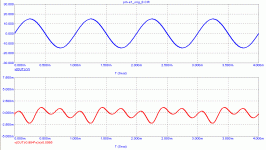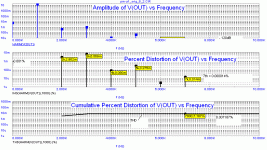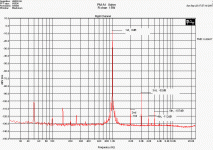Interestig answers 😀
Lumanauw, you are absolutely out. Have you tried to see the shape of distortion and calculate % of distortion from amplitudes? 😀
I would like to see especially Charles Hansen input, who seems to correlate FFT and fundamental notched so well. Then I will show a spectrum.
IMHO, it is sometimes almost impossible to get it by memory. Only certain cases with high distortion and predominant one spectral line can be guessed.
Lumanauw, you are absolutely out. Have you tried to see the shape of distortion and calculate % of distortion from amplitudes? 😀
I would like to see especially Charles Hansen input, who seems to correlate FFT and fundamental notched so well. Then I will show a spectrum.
IMHO, it is sometimes almost impossible to get it by memory. Only certain cases with high distortion and predominant one spectral line can be guessed.
I'm out? 😀 I remember the shape of your picture (red curve), the "shoulders" are gone when I increase bias (in my amp), and the residual becomes sinusoidal without "shoulders". The more bias (approaching pure classA), the residual becomes simpler and smaller in magnitude.
1.75A? Well, it isn't the underbiased case then.
What has changed between your two graphs? I guess the setting of the distortion meter has changed. Shifting the center frequency or the balance may alter the shape of the residual seen on scope (with the same everything).
What has changed between your two graphs? I guess the setting of the distortion meter has changed. Shifting the center frequency or the balance may alter the shape of the residual seen on scope (with the same everything).
PMA, are you saying the residual of 1 amp with the same everything can be altered, can be looked good and bad?
lumanauw said:PMA, are you saying the residual of 1 amp with the same everything can be altered, can be looked good and bad?
Not exactly. I am saying that residual strongly depends on fine tuning of the method and that it is difficult to say "Look at the residual, the FFT is bad!" IMHO opposite is true. Decent FFT gives me more information.
Regarding "can be looked good and bad?" - no. In case it is badly distorted, no gain tuning helps. But, you might have a point. Stereophile NEVER shows sensitivity on Y-axis of residual, and this is wrong, IMHO.
PMA said:Not exactly. I am saying that residual strongly depends on fine tuning of the method and that it is difficult to say "Look at the residual, the FFT is bad!" IMHO opposite is true. Decent FFT gives me more information.
Pavel,
first - as far as I can see, the only difference between these three graphs are different levels of the fundamental present. I still can count to 3 🙂 . However (thought obviously FFT would give you detailed information about the levels) it is quite impossible not to see the difference between a distortion residual with prevailing 2nd and one where 9th and 7th are larger than 2nd and 3rd. Charles is quite right - two pictures of supposedly same measurement do not match. And the level of a fundamental is not a problem there 🙂 .
Cheers
Alex
Alex,
I have not done measurements for Stereophile, so I cannot say into the deep how well their different methods match. But high order harmonics often show only sharpening of the residual.
Now, could you guess from my images how the spectrum would look like. Yes, it is easy from the last image, originally I only wanted to show the 1st one.
Okay, what is my distortion?
I have not done measurements for Stereophile, so I cannot say into the deep how well their different methods match. But high order harmonics often show only sharpening of the residual.
Now, could you guess from my images how the spectrum would look like. Yes, it is easy from the last image, originally I only wanted to show the 1st one.
Okay, what is my distortion?
PMA said:Alex,
I have not done measurements for Stereophile, so I cannot say into the deep how well their different methods match. But high order harmonics often show only sharpening of the residual.
Now, could you guess from my images how the spectrum would look like. Yes, it is easy from the last image, originally I only wanted to show the 1st one.
Okay, what is my distortion?
Pavel,
It is quite obvious that FFT would give more information about the distortion structure. However from all 3 of your pictures is clear that the 3rd harmonic is much higher than the rest. In the same way from the residual trace in Stereophile obvious that the 2nd should be much higher than the rest. On FFT graph it is not the case. Which one should we believe? One thing is clear - two graphs do not match, so it is impossible to make ANY conclusions except one - John A made a mistake somewhere 🙂 .
Cheers
Alex
x-pro said:
Pavel,
... However from all 3 of your pictures is clear that the 3rd harmonic is much higher than the rest. In the same way from the residual trace in Stereophile obvious that the 2nd should be much higher than the rest.
Alex,
OK, let us forget Stereophile and concentrate to my example. You have told your estimation. Let us wait a while if anyone else comes with his. Then I will show FFT result and also measurement of the real amp under these conditions. It is into 8 ohms. And we shall see how well we can predict spectrum from the residual, and how well our assumptions match with reality.
Regards,
Pavel
Right on Alex. The measurement residual picture does NOT match the FFT higher harmonics. Second must be much larger. I once saw this more than 30 years ago with a synthetic tone ic that made a 'staircase' approximation of the sine wave. It is either that, or low bit artifacts, I suspect. Come on, all you modern digital experts! Get with it and explain it.😀
It is easy. One of the measurements is wrong. And J.A. has very low dynamic range, everything under -100dB seems to be unreliable with his old equipment (still not as old as 35 years).
The worst mistake is that he does not scale the residual. Though, we can see a lot of high order mess even in the residual measurement.
The worst mistake is that he does not scale the residual. Though, we can see a lot of high order mess even in the residual measurement.
janneman said:
Hi Glen,
I can see you used your time away well! 😀
Jan Didden
They can’t tame me, Jan 😀
Half of the sentence was in vain though, coz I waz away, working in a coalfield.
Here is what you call a truck. That fuel tank holds 3000 litres of diesel, the tipper 240 tones of coal and motion is provided by a locomotive type diesel-electric scheme utilising a V16 combustion engine and a pair of electric motors for rear wheels (you and see the rear of one of the motors in the space of the rear
wheel hub).
I was thinking that that V16 and the attached generator/alternator would make a nice power source for a pretty hefty bank of audio power amplifiers.........
Cheers,
Glen
Attachments
But, how big is the fuel pipe coming into the generator? Is background noise a problem if we keep the generator to amplifier cables short?G.Kleinschmidt said:
I was thinking that that V16 and the attached generator/alternator would make a nice power source for a pretty hefty bank of audio power amplifiers.........
G.Kleinschmidt said:
So long as the teflon wire has been sufficiently burnt-in and the snubber networks have been expertly tuned to quash objectionable transgressive sonic impulses, overstuffed marshmallows will sound lusciously translucent in their spontaneity.
This is both quite unlike and in stark contrast to the beleaguered and impotent performance of Edmond’s noxiously misguided, band-aided designs, which corrupt sonic experiences with the full deleterious force of sinisterly applied negative feedback to the tune of amorous periwinkles.
It is only through the scholarly study of the linguistic and communicative abilities of gorillas that this profound dichotomy can be fully understood mostly in its entirety.
Surely You're Joking, Mr. ........ Kleinschmidt!
Thanks Glen.
Cheers, Edmond.
- Home
- Amplifiers
- Solid State
- Bob Cordell Interview: BJT vs. MOSFET




